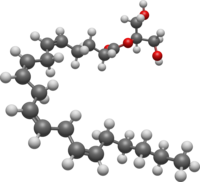2-花生四烯酸甘油
外观
| 2-花生四烯酸甘油 | |
|---|---|

| |

| |
| IUPAC名 2-O-[(5Z,8Z,11Z,14Z)-Icosa-5,8,11,14-tetraenoyl]glycerol | |
| 系统名 1,3-Dihydroxypropan-2-yl (5Z,8Z,11Z,14Z)-icosa-5,8,11,14-tetraenoate | |
| 别名 | 2-AG, 2-arachidonoylglycerol |
| 识别 | |
| CAS号 | 53847-30-6 |
| PubChem | 5282280 |
| ChemSpider | 4445451 |
| SMILES |
|
| InChI |
|
| InChIKey | RCRCTBLIHCHWDZ-DOFZRALJBN |
| ChEBI | 52392 |
| IUPHAR配体 | 729 |
| 性质 | |
| 化学式 | C23H38O4 |
| 摩尔质量 | 378.55 g·mol−1 |
| 若非注明,所有数据均出自标准状态(25 ℃,100 kPa)下。 | |
2-花生四烯酸甘油, 2-AG(2-Arachidonoylglycerol)[1][2] ,又称为内源性大麻素,是内源性CB1配体。1995年,拉斐尔·梅舒朗及其學生與合作者在實驗室中發現了2-AG [3]。大麻素會激活位於神經元末端的2-AG受體,從而使神經元誤以為已經向突觸處相連的其他神經元發送了信息(神經遞質),從而錯誤地抑制神經遞質的釋放。[4]
2-AG在中枢神经系统中有较高的表达,同时可以在乳汁中检测到。
2-AG在免疫反应中起调控作用。
参考文献
[编辑]- ^ Stella N, Schweitzer P, Piomelli D. A second endogenous cannabinoid that modulates long-term potentiation (PDF). Nature. August 1997, 388 (6644): 773–8 [2023-11-30]. Bibcode:1997Natur.388..773S. PMID 9285589. S2CID 4422311. doi:10.1038/42015
 . (原始内容存档 (PDF)于2018-07-24).
. (原始内容存档 (PDF)于2018-07-24).
- ^ Sugiura T, Kodaka T, Nakane S, et al. Evidence that the cannabinoid CB1 receptor is a 2-arachidonoylglycerol receptor. Structure-activity relationship of 2-arachidonoylglycerol, ether-linked analogues, and related compounds. The Journal of Biological Chemistry. January 1999, 274 (5): 2794–801. PMID 9915812. doi:10.1074/jbc.274.5.2794
 .
.
- ^ Mechoulam R, Ben-Shabat S, Hanus L, Ligumsky M, Kaminski NE, Schatz AR, Gopher A, Almog S, Martin BR, Compton DR, Pertwee RG. Identification of an endogenous 2-monoglyceride, present in canine gut, that binds to cannabinoid receptors. Biochemical pharmacology (Elsevier). 1995, 50 (1): 83––90.
- ^ James Kalat. Biological Psychology, 14th Edition. Cengage Learning. 2023: 58.
